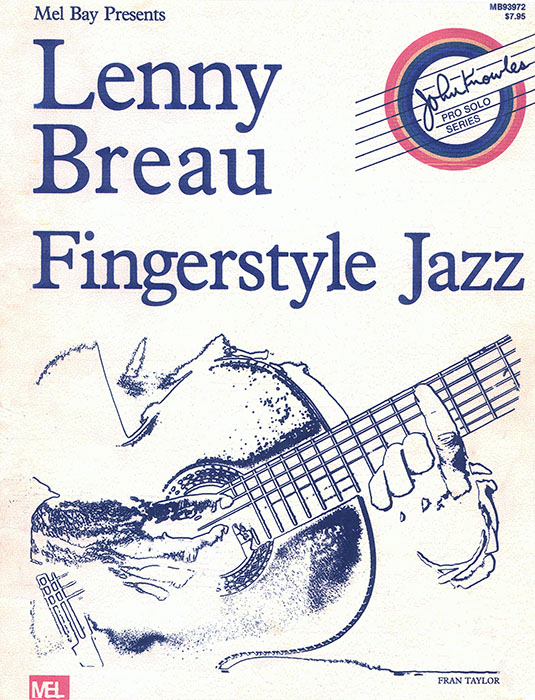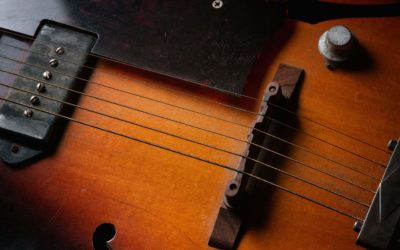Table of Contents
Book Review: “Fingerstyle Jazz” – Lenny Breau
In the world of Fingerstyle Jazz, few practitioners are as revered as Lenny Breau. Considered my many to be one of the greatest guitarists who ever lived, Breau revolutionized the genre. “Fingerstyle Jazz” presents some of his concepts in book form.
Background
Lenny Breau was a prodigy who was conceived by two performing Country and Western parents. He started playing at the age of eight and was playing in bands as early as twelve years old and joining his parent’s band at age fourteen.
Although he had originally performed Country and Western material, he eventually felt the siren’s call of Jazz and moved in that direction. His talents garnered him studio work and even his own Canadian TV show, “The Lenny Breau Show”. He had a wide range of musical influences, and a deep interest in pianist Bill Evans.
Although he worked in trios, it was his solo guitar playing that elevated him to “genius” status. Like many solo guitarists, Breau wanted to expand the range of the instrument. However, unlike other guitarists, who used a low “A” bass string, Breau envisioned a 7 string guitar that had an extended high end with a high “A” string.

Fingerstyle Jazz
Measuring in at only 60 pages, the book is divided into two sections. The first section is called, “Seminar”, and the second, “Solos”.
One could think of the “Seminar” section as as the learning/preparation material used for playing the songs in the “Solo” section. This section covers three topics: “Buildin’ the Blues”, “Three Against Two” and “Harmonics at Work”.
The “Solos” section includes three transcribed solo pieces as performed by Lenny Breau on the original recordings. These include, “Five O’Clock Bells”, “Little Blues” and “Freight Train”.
The material is geared towards the intermediate to advanced player, with the actual Breau solo pieces being clearly aimed at advanced players, especially “Little Blues” and “Freight Train”.
Audio
When I obtained my original copy of the book it came with a cassette tape. The tape has Breau talking to John Knowles about the examples in the “Seminar” section of the book. Throughout this section, Lenny’s quotes from the tape are highlighted in a bold font and marked “Lenny:” or “L”, and editor John Knowles would be marked “John” or “J”. It’s great to hear Lenny explaining his thoughts on the material, as well as playing it!
Later editions of the book contain a CD, while the current book uses online audio.
Seminar: Buildin’ The Blues
Breau first introduces an eighth note rhythm using one note on the top string. He then proceeds to take that figure and play two note chords at the beginning of each measure below it.
Once the student is familiar with the aforementioned figure, Breau then takes it and turns it into a little melody. As he continues, each step of the way embellishes upon the preceding material and introduces a new concept. Syncopation is introduced by starting the chord playing on the “and” of a beat.
After the preceding material he moves onto applying the pentatonic scale to the chords, this time on the first three strings and playing the chords on the fourth and fifth.
He keeps expanding on each example until he arrives at the final version which contains all of the previous concepts. He then moves onto playing the blues with a Mixolydian mode for a different color/sound.
From there to the end Lenny plays more “complex” variations of the material, each time emphasizing a particular point.
Seminar: Three Against Two
This short four page section is devoted to playing quarter note triplets against quarter notes. This is often a stumbling block for students when they first attempt fingerstyle guitar. Fortunately this is made easier by the fact that you have a recorded example of Lenny playing the material. It is best to listen to him play it and then attempt to emulate his playing and internalize the sound/feel.
He then moves onto mixing quarter note triplets with eight note triplets over quarter notes. Again, it is best to listen and absorb, rather than trying to read the rhythms off the paper. Though you should learn to do both.
The final examples are based on “Freight Train”, which moves the triplets to the bass notes.
Seminar: Harmonics at Work
For many, including myself, this is the section that we primarily bought the book for. This is the quintessential Lenny Breau technique.
Starting with the basic open string harmonics, Lenny then moves onto playing an ascending melodic line from “D” to “G” by playing the open fourth string and then hitting the harmonic on the 12th fret, 6th string and continuing this picking pattern across the other four strings. This is the main right hand, alternation, technique that is needed to play the cascading harmonics.
Once the player has gotten used to the above technique, Lenny then introduces harmonics mixed with pull-offs, as well as a study that uses the preceding techniques.
After the single note harmonics, Lenny introduces the use of harmonics at the same time as playing chords, thus elevating the note played with a harmonic up an octave for some interesting voicings.
Different chord types and progressions are explored.
Solos
The second part of the book contains three transcribed Breau pieces, “Five O’Clock Bells”, “Little Blues” and “Freight Train”. While “Five O’Clock Bells” is approachable, the other two pieces are much more technically challenging. Keep in mind that Lenny used a thumb pick, so players who use their thumbs/fingers will find some of the faster passages to be challenging.
Like Ted Greene and George Van Eps, Lenny’s albums were not easy to find back in the 80’s, thus finding the recorded versions of these songs was a challenge. Fortunately these tunes can now be found on YouTube, as well as many online stores.
Discography
The Discography section lists the albums that the transcribed songs are located on, as well as other albums that were available at the time the book was published (1985).
https://www.melbay.com/Products/93972M/lenny-breau-fingerstyle-jazz.aspx
Summary
There’s no doubt that Lenny Breau was an amazing guitarist, a giant in his field. Even today his playing sounds fresh and innovative. So it’s not surprising that a book that sheds some insight into his approach and technique would be of interest.
The book presents some interesting material, but overall it seems like a somewhat cursory overview of his overall technique. Although the material is geared toward intermediate and advanced guitarists, the approach and examples seem more suited for those just starting on these techniques and the more developed concepts are not explored.
Instruction wise, I thought that the “Buildin’ the Blues” section was the best, as it took a simple idea and kept building upon it. It also showed how Breau would use little two note “chords” to provide the harmonic accompaniment behind his upper line melodies. I would have been great if this concept was given its own section of the book, as it was something that I’m sure many guitarists would have been interested in.
It was nice to have recorded examples available of Lenny playing the “Three Against Two” examples, as it is much easier to “hear” it than it is to “count” it. It provides a aural guidance as to what the student is to aspire towards.
Of course the section on the cascading harmonics is probably why many people bought the book. It is an interesting section, however, I rarely use it, as it just screams “Lenny Breau”. It has become the Jazz/Fingerstyle equivalent of Van Halen’s finger tapping. Nonetheless, it should be known and hopefully someone in the future will expand upon it.
It is still a joy to hear Lenny talking about what he is doing. This was somewhat revolutionary back in the ’80’s where there were few sources of this type of information. This was pre-YouTube or internet, and was one of the few sources to be able to actually hear the artist speak.
One of the shortcomings of the book is that there is little to no information about Lenny himself. It would have been nice to have included some previous interviews or such that contained his influences and favorite albums, as these both contribute to the background of his technical development. Though it should be noted that he does mention both Chet Atkins and pianist Bill Evans in his introduction.
There is also no mention of his use of a thumbpick or the benefits/disadvantages of using one. This would seem to be a pretty important point when discussing Breau’s technique.
Overall, this is a book that would serve as a nice introduction to some of Lenny’s techniques, but I can’t help but feel that it is too short and just barely scratches the surface of what this genius had to offer.
Recommended!
Final Words
I’m happy to see that many of you took advantage of the “March Madness” sale for my “Contrapuntal Improvisation” book. Thank you for your interest and support! (As of this writing, there is still a couple of days left, for those who might be interested!)





0 Comments